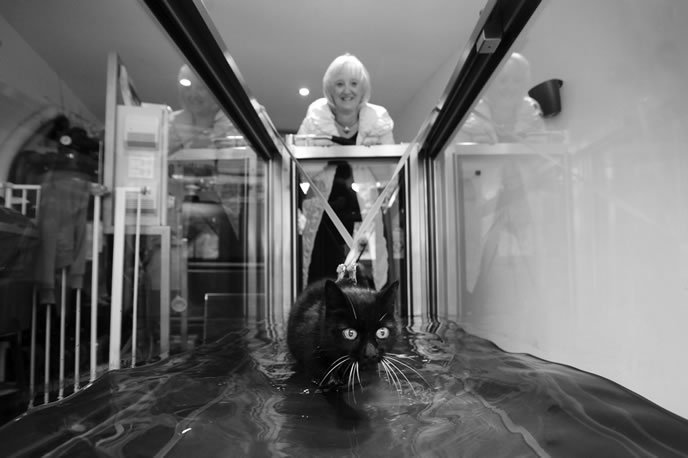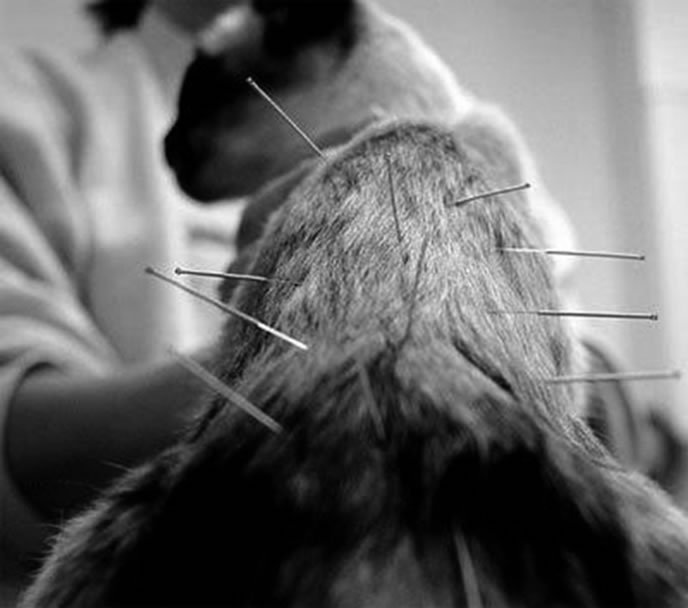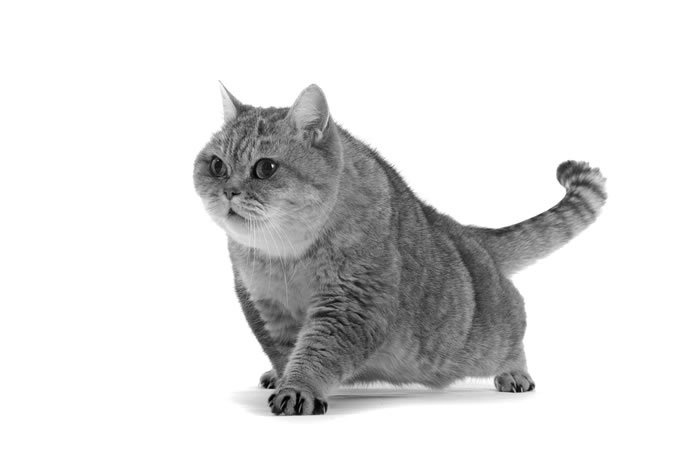The cats hip problem was so painful that he required a femoral head osteotomy, the surgical removal of the top of the thighbone forming the ball and socket joint. Afterward, the supporting muscle needed to be strengthened to bear the cats weight, but he refused to use his limb.
Caters News Agency

The solution: Exercise in an underwater treadmill twice a week for two or three weeks. Movement is easier underwater, and the resistance of the water helps strengthen muscle. It got the cat jump-started into using the leg better, says Joseph Wakshlag, DVM, Ph.D., one of 83 specialists in the U.S. certified by the American College of Veterinary Sports Medicine and Rehabilitation. He heads the Sports Medicine and Rehabilitation service at Cornell University Hospital for Animals.
Recovery from Surgery. Cats on underwater treadmills? Yes, indeed. Veterinarians at universities and specialty practices now offer a range of therapies to help cats recover from or manage surgery, arthritis pain, obesity and neurological diseases that affect their mobility. Medical doctors send patients to physical therapy after orthopedic injuries, surgery and heart attacks, Dr. Wakshlag says. If people come back quicker and better after rehabilitation, why wouldnt a cat or dog?
In fact, pet owners who have experienced the benefits of physical therapy are more likely to seek it for their pets. The American Veterinary Medical Association approved rehabilitation as a specialty in 2010. (The term physical therapy is limited to humans.) Cornell has offered rehabilitation for some time but recently renamed the program, formerly known as pain management.

Among the techniques Cornell offers for cats are:
– Laser therapy for pain and healing. In Class IV laser therapy, which has long been used on human patients, the specialist directs an intense beam of light into tissues to reduce swelling, increase circulation or block a nerves ability to send a pain signal to the brain. The light energy, which alters or stimulates cellular function, is intended to help wound healing and inflammatory conditions in leg joints and the lower back.
– Therapeutic ultrasound for tendon and ligament injuries.
– Transcutaneous (through the skin) electrical stimulation for pain and neurologic problems. An electrical current is used to help with nerve regeneration after back surgery and prevent muscle atrophy from disuse.
– Joint mobilizations and exercise regimens utilizing ramps and everyday cat perches to keep joints mobile.
– Rounding out the list: the underwater treadmill for the right cats, Dr. Wakshlag says.
Rehabilitation specialists treat cats with complicated fractures, limb amputations and deformities that cause problems with limb usage. For instance, cats who have undergone an amputation must learn how to walk on three legs. Some Manx cats have an inherited condition called sacral caudal dysgenesis, a malformation of the vertebrae of the lower back and tail that causes tailless or bobtailed cats to have difficulty using their hind legs. Often just using perches and treats to get them flexing and extending their legs properly can be helpful, Dr. Wakshlag says.
The University of Tennessee, the first institution to offer certification courses in animal rehabilitation, has graduated more than 850 individuals from its program since it began in 2001. Marti Drum, DVM, Ph.D., a clinical assistant professor at the Universitys College of Veterinary Medicine in Knoxville, most commonly treats traumatic orthopedic injuries such as pelvic fractures, deranged stifles – in which all the ligaments of the knee are traumatically torn – and spinal cord injuries. But many senior cats could benefit from rehab, she says:
It is estimated that up to 90 percent of geriatric cats suffer from arthritis in one or more joints, but rarely do we treat cats because signs of arthritis often go unrecognized in them. I would love to have the opportunity for more cats to receive the benefits of rehabilitation for arthritis.
Nerve Damage. Fortunately for cats, their anatomy makes them less likely than dogs to suffer traumatic injuries. Theyre light on their feet and their joints are more flexible, but they are susceptible to arthritis, especially of the spine, as well as nerve damage from trauma.
Dr. Drum recalls the case of Elmo, an obese sealpoint Siamese whose hip arthritis was so severe he couldnt and wouldnt use his litter box. However, his laidback and loving temperament, dedicated owners and sessions on an underwater treadmill helped him regain mobility.
With a little weight loss, he began resuming normal litter box habits and eventually began jumping small heights again, Dr. Drum says. Some of our more successful cases were geriatric cases where people were thinking of putting the animal down or were not sure what to do. I think we made very positive advancements with some of those pets as far as their ability to get up, get down, keeping them active and mobile when they were potentially near the end of their life.
Bigstock

Range of Motion. Rehab typically starts with evaluating the animals range of motion in the affected area. We measure muscle mass, girth and fitness and then we try to improve on all of them, Dr. Wakshlag says. We try to rebuild muscle and improve range of motion and, in effect, the joint, so we tend to use many different therapies and a lot of it is home exercise programs.
Surprisingly, some cats are good patients but compliance is often an issue. Not every cat is willing to walk on an underwater treadmill or do routines that involve an exercise ball or assistive device, such as ramps or balance boards. Rehab specialists may encourage them to move by showing them a favorite treat, using catnip toys or dangling a fishing lure toy or feather.
Short Attention. Recognizing and working with the short feline attention span are also musts. When a cat indicates that hes tired of an activity, its best not to push him. The patients I have worked with have been very compliant, but I am also very attuned to cat behavior and tolerance during therapy, Dr. Drum says. It is essential that all my patients are willing participants, but it is even more critical with felines since they can become very stressed. If a cat is not tolerating a therapy or exercise, then we stop.
Cats who enjoy being touched respond best to rehab. Those who dislike touch are more difficult to work with, but some owners have been successful by wearing heavy gloves to protect their hands from scratches or bites when they perform massage, exercises and stretches to help keep joints flexible with their cat at home. Some owners build small ramps and encourage their cats to walk up and down them for treats.
Diet is important, too, since carrying around extra weight makes rehabilitation more difficult. A strict diet plan is often part of the rehabilitation plan and all rehab specialists are well versed in obesity management as part of their training, Dr. Wakshlag says. A rehab veterinarian may recommend supplements with anti-inflammatory effects such as fish oil or glucosamine-chondroitin.
Age is not a disease, Dr. Wakshlag says. Many ailments that come with aging are definitely treatable, and this extra attention to details regarding movement, behavior and pain management is all part of this growing area of rehabilitation in our family pets. As your cat ages and doesnt do the things that he or she used to do, which can be concerning – look up one of the American College of Sports Medicine and Rehabilitation specialists – they may be able to take off a few years and help your cat rediscover life again.



